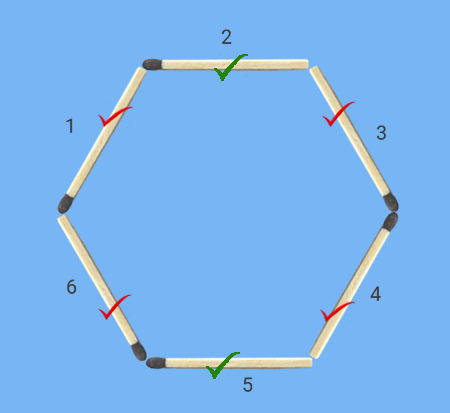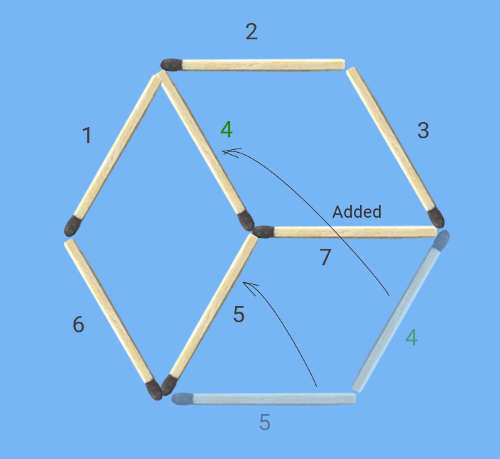
From a hexagon of matchsticks, move 2 matches and add 1 to make 2 diamonds.

Time to solve the tricky matchstick puzzle is 5 minutes.
Solution to the matchstick puzzle Move 2 matches and add 1 to make 2 diamonds: Deciding the strategy to adopt
Would you try your luck by moving any 2 matches? Or, it would make much better sense to have an idea of how the final solution figure would look like!
Sure, it is by far the most sensible idea to know first where you have to go, your destination.
Here, what kind of 2 diamond matchstick structure can be our solution figure is our first target to know. This is the way to go.
Once we know the final solution figure, later we can think of a way of making the figure from the initial puzzle figure.
Solution to the matchstick puzzle Move 2 matches and add 1 to make 2 diamonds: Trial on 2 diamonds matchstick structures and number of matchstick analysis
With little effort we take the easy path of a trial final figure of 2 diamonds as shown.

Can it be the final solution figure?
No, it can't be. It has 8 matches whereas if you move 2 matches in the 6 match hexagon and add 1 match, the total number of matches becomes 7, not 8.
It means, the final solution figure of 2 diamonds must have 1 common side between the two. Following is such a trial final 2 diamonds figure with one common side between 2 diamonds.

Can you form the possible 2 diamonds on the right from the hexagon on the left?
Let's see.
Only two tick-marked sides are common between the two figures and so you can never move just 2 matches and add 1 to make the 2 diamonds from the hexagon.
Though this attempt has also failed, we have gained a valuable insight into,
What type of matches in the hexagon must remain UNMOVED.
Solution to Move 2 matches and add 1 to make 2 diamonds matchstick puzzle: A new approach: Analyzing which stick must remain UNMOVED
From the previous trial experience, you have decided to leave the approach of forming trial possible figures and comparing with initial figure. Its job is over.
Now you will give more attention to the individual matches in the starting hexagon to classify them according to their positioning in the hexagon structure. You are sure that this classification will lead you to the solution unerringly.
Following is the hexagon figure repeated, but with each stick numbered for easy analysis and referring to the individual sticks.

Now, with a new awareness of the importance of positioning, it is easy for you to classify the six matches into only two classes,
- Type 1: Pairs of matches 1, 6 and 3, 4. Each of these pairs of matches are obliquely placed and joined at one end thus forming a pair. A pair of this type is perfect for being two sides of a diamond.
- Type 2: Two separated matches 2 and 5 both horizontal and apparently unsuitable for being a side of a diamond.
You have already seen that whatever be the final solution, an oblique pair like matches 1 and 6 must be forming two sides of the solution figure. In other words, these two matches must remain unmoved.
At this point it is absolutely clear that you just have to identify two more matches that must remain UNMOVED. Moving the rest two will give you a very clear idea of where to place the additional 7th match.
This approach is analytical and intuitively easier, you feel.
What other two matches must remain unmoved?
Can you keep the other oblique pair 3, 4 unmoved? It won't be feasible as these two are wrongly placed and further away from the first fixed pair to be part of a second diamond that has one common side with the first one.
The pair of matches 2 and 5 are still more impossible to be a part of a second diamond.
The only remaining possibility is a pair of matches ONE from Type 1 and the SECOND from Type 2 that are joined together.
You can visualize the solution now.
Keep matches 1, 6 fixed. Next, keep two more matches either 2, 3 or 4, 5 fixed. Each will give you a feasible solution. Assume, you have matches 1, 6, 2 and 3 fixed.
Move the rest two matches 4 and 5 to complete a diamond with sides 1 and 6. Thus, the possibility of a second diamond with only one side missing will be created. Add 1 extra match to complete this remaining side of the second diamond.
Solution figure is shown.

Match number 7 is the extra match you have added.
Following an easy and systematic approach, you have learned the right way to get the final solution figure.
Know how to solve difficult problems easily without wasting time on random attempts
Our ebook on puzzle solutions by innovative methods will show you just that.
Puzzles for Adults: 50 Brain Teasers with Step-by-Step Solutions: Boost Your Power of Problem Solving
BUY the eBook Amazon Kindle version here, from Google Play here and Paperback here.
Second book on Innovative Solutions to Matchstick Puzzles from Suresolv

BUY Creative Matchstick Puzzles Innovative Solutions eBook Amazon Kindle version
BUY the paperback here.
Puzzles you may enjoy
Easy to hard brain teasers with systematic solutions
Challenging brain teasers with solutions: Long list.
This will always be the most up-to-date full list with the brain teasers classified into categories that can be browsed separately.
You may also click on the category term link below to enjoy the brain teasers that are classified in the present category.
For example, if the category term link shown below is "Riddle", click on it to go through all the Riddles.
